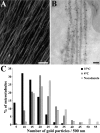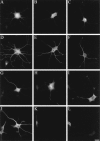STOP proteins are responsible for the high degree of microtubule stabilization observed in neuronal cells
- PMID: 9660871
- PMCID: PMC2133033
- DOI: 10.1083/jcb.142.1.167
STOP proteins are responsible for the high degree of microtubule stabilization observed in neuronal cells
Abstract
Neuronal differentiation and function require extensive stabilization of the microtubule cytoskeleton. Neurons contain a large proportion of microtubules that resist the cold and depolymerizing drugs and exhibit slow subunit turnover. The origin of this stabilization is unclear. Here we have examined the role of STOP, a calmodulin-regulated protein previously isolated from cold-stable brain microtubules. We find that neuronal cells express increasing levels of STOP and of STOP variants during differentiation. These STOP proteins are associated with a large proportion of microtubules in neuronal cells, and are concentrated on cold-stable, drug-resistant, and long-lived polymers. STOP inhibition abolishes microtubule cold and drug stability in established neurites and impairs neurite formation. Thus, STOP proteins are responsible for microtubule stabilization in neurons, and are apparently required for normal neurite formation.
Figures








Similar articles
-
STOP (stable-tubule-only-polypeptide) is preferentially associated with the stable domain of axonal microtubules.J Neurocytol. 2003 May;32(4):399-413. doi: 10.1023/B:NEUR.0000011334.70648.87. J Neurocytol. 2003. PMID: 14724383
-
STOP proteins.Cell Struct Funct. 1999 Oct;24(5):393-9. doi: 10.1247/csf.24.393. Cell Struct Funct. 1999. PMID: 15218867
-
Astrocytes and oligodendrocytes express different STOP protein isoforms.J Neurosci Res. 2004 Nov 1;78(3):329-37. doi: 10.1002/jnr.20260. J Neurosci Res. 2004. PMID: 15389836
-
[A role for microtubules in mental diseases?].Pathol Biol (Paris). 2004 Mar;52(2):89-92. doi: 10.1016/j.patbio.2003.04.007. Pathol Biol (Paris). 2004. PMID: 15001237 Review. French.
-
A role of microtubules during the formation of cell processes in neuronal and non-neuronal cells.Cell Tissue Res. 1998 Feb;291(2):163-74. doi: 10.1007/s004410050988. Cell Tissue Res. 1998. PMID: 9426305 Review.
Cited by
-
Neurofilaments bind tubulin and modulate its polymerization.J Neurosci. 2009 Sep 2;29(35):11043-54. doi: 10.1523/JNEUROSCI.1924-09.2009. J Neurosci. 2009. PMID: 19726663 Free PMC article.
-
CRMP4-mediated fornix development involves Semaphorin-3E signaling pathway.Elife. 2021 Dec 3;10:e70361. doi: 10.7554/eLife.70361. Elife. 2021. PMID: 34860155 Free PMC article.
-
Dishevelled-1 regulates microtubule stability: a new function mediated by glycogen synthase kinase-3beta.J Cell Biol. 2000 Oct 2;151(1):83-94. doi: 10.1083/jcb.151.1.83. J Cell Biol. 2000. PMID: 11018055 Free PMC article.
-
Deletion of the STOP gene, a microtubule stabilizing factor, leads only to discrete cerebral metabolic changes in mice.J Neurosci Res. 2008 Mar;86(4):813-20. doi: 10.1002/jnr.21550. J Neurosci Res. 2008. PMID: 17969102 Free PMC article.
-
Tau and MAP6 establish labile and stable domains on microtubules.iScience. 2025 Jan 29;28(3):111785. doi: 10.1016/j.isci.2025.111785. eCollection 2025 Mar 21. iScience. 2025. PMID: 40040809 Free PMC article.
References
-
- Baas PW, Pienkowski TP, Cimbalnik KA, Toyama K, Bakalis S, Ahmad FJ, Kosik KS. Tau confers drug stability but not cold stability to microtubules in living cells. J Cell Sci. 1994;107:135–143. - PubMed
-
- Barra HS, Arce CA, Argaraña CE. Posttranslational tyrosination/detyrosination of tubulin. Mol Neurobiol. 1988;2:133–153. - PubMed
Publication types
MeSH terms
Substances
Associated data
- Actions
LinkOut - more resources
Full Text Sources
Other Literature Sources
Molecular Biology Databases

